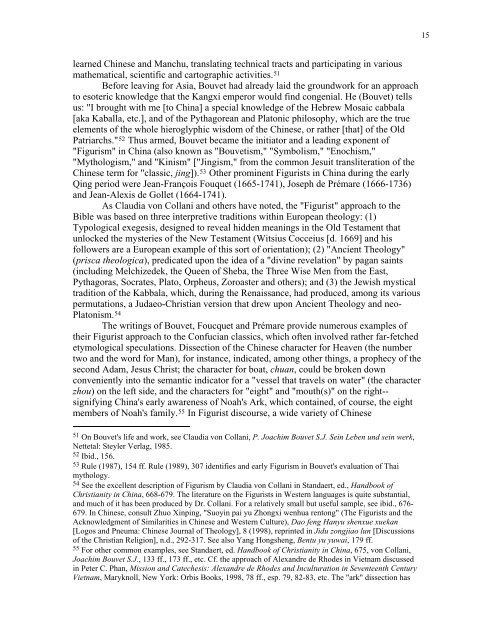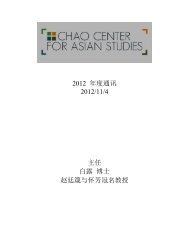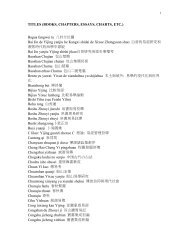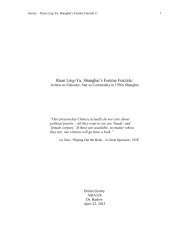Jesuit Interpretations of the Yijing - Chao Center for Asian Studies ...
Jesuit Interpretations of the Yijing - Chao Center for Asian Studies ...
Jesuit Interpretations of the Yijing - Chao Center for Asian Studies ...
Create successful ePaper yourself
Turn your PDF publications into a flip-book with our unique Google optimized e-Paper software.
15<br />
learned Chinese and Manchu, translating technical tracts and participating in various<br />
ma<strong>the</strong>matical, scientific and cartographic activities. 51<br />
Be<strong>for</strong>e leaving <strong>for</strong> Asia, Bouvet had already laid <strong>the</strong> groundwork <strong>for</strong> an approach<br />
to esoteric knowledge that <strong>the</strong> Kangxi emperor would find congenial. He (Bouvet) tells<br />
us: "I brought with me [to China] a special knowledge <strong>of</strong> <strong>the</strong> Hebrew Mosaic cabbala<br />
[aka Kaballa, etc.], and <strong>of</strong> <strong>the</strong> Pythagorean and Platonic philosophy, which are <strong>the</strong> true<br />
elements <strong>of</strong> <strong>the</strong> whole hieroglyphic wisdom <strong>of</strong> <strong>the</strong> Chinese, or ra<strong>the</strong>r [that] <strong>of</strong> <strong>the</strong> Old<br />
Patriarchs." 52 Thus armed, Bouvet became <strong>the</strong> initiator and a leading exponent <strong>of</strong><br />
"Figurism" in China (also known as "Bouvetism," "Symbolism," "Enochism,"<br />
"Mythologism," and "Kinism" ["Jingism," from <strong>the</strong> common <strong>Jesuit</strong> transliteration <strong>of</strong> <strong>the</strong><br />
Chinese term <strong>for</strong> "classic, jing]). 53 O<strong>the</strong>r prominent Figurists in China during <strong>the</strong> early<br />
Qing period were Jean-François Fouquet (1665-1741), Joseph de Prémare (1666-1736)<br />
and Jean-Alexis de Gollet (1664-1741).<br />
As Claudia von Collani and o<strong>the</strong>rs have noted, <strong>the</strong> "Figurist" approach to <strong>the</strong><br />
Bible was based on three interpretive traditions within European <strong>the</strong>ology: (1)<br />
Typological exegesis, designed to reveal hidden meanings in <strong>the</strong> Old Testament that<br />
unlocked <strong>the</strong> mysteries <strong>of</strong> <strong>the</strong> New Testament (Witsius Cocceius [d. 1669] and his<br />
followers are a European example <strong>of</strong> this sort <strong>of</strong> orientation); (2) "Ancient Theology"<br />
(prisca <strong>the</strong>ologica), predicated upon <strong>the</strong> idea <strong>of</strong> a "divine revelation" by pagan saints<br />
(including Melchizedek, <strong>the</strong> Queen <strong>of</strong> Sheba, <strong>the</strong> Three Wise Men from <strong>the</strong> East,<br />
Pythagoras, Socrates, Plato, Orpheus, Zoroaster and o<strong>the</strong>rs); and (3) <strong>the</strong> Jewish mystical<br />
tradition <strong>of</strong> <strong>the</strong> Kabbala, which, during <strong>the</strong> Renaissance, had produced, among its various<br />
permutations, a Judaeo-Christian version that drew upon Ancient Theology and neo-<br />
Platonism. 54<br />
The writings <strong>of</strong> Bouvet, Foucquet and Prémare provide numerous examples <strong>of</strong><br />
<strong>the</strong>ir Figurist approach to <strong>the</strong> Confucian classics, which <strong>of</strong>ten involved ra<strong>the</strong>r far-fetched<br />
etymological speculations. Dissection <strong>of</strong> <strong>the</strong> Chinese character <strong>for</strong> Heaven (<strong>the</strong> number<br />
two and <strong>the</strong> word <strong>for</strong> Man), <strong>for</strong> instance, indicated, among o<strong>the</strong>r things, a prophecy <strong>of</strong> <strong>the</strong><br />
second Adam, Jesus Christ; <strong>the</strong> character <strong>for</strong> boat, chuan, could be broken down<br />
conveniently into <strong>the</strong> semantic indicator <strong>for</strong> a "vessel that travels on water" (<strong>the</strong> character<br />
zhou) on <strong>the</strong> left side, and <strong>the</strong> characters <strong>for</strong> "eight" and "mouth(s)" on <strong>the</strong> right--<br />
signifying China's early awareness <strong>of</strong> Noah's Ark, which contained, <strong>of</strong> course, <strong>the</strong> eight<br />
members <strong>of</strong> Noah's family. 55 In Figurist discourse, a wide variety <strong>of</strong> Chinese<br />
51 On Bouvet's life and work, see Claudia von Collani, P. Joachim Bouvet S.J. Sein Leben und sein werk,<br />
Nettetal: Steyler Verlag, 1985.<br />
52 Ibid., 156.<br />
53 Rule (1987), 154 ff. Rule (1989), 307 identifies and early Figurism in Bouvet's evaluation <strong>of</strong> Thai<br />
mythology.<br />
54 See <strong>the</strong> excellent description <strong>of</strong> Figurism by Claudia von Collani in Standaert, ed., Handbook <strong>of</strong><br />
Christianity in China, 668-679. The literature on <strong>the</strong> Figurists in Western languages is quite substantial,<br />
and much <strong>of</strong> it has been produced by Dr. Collani. For a relatively small but useful sample, see ibid., 676-<br />
679. In Chinese, consult Zhuo Xinping, "Suoyin pai yu Zhongxi wenhua rentong" (The Figurists and <strong>the</strong><br />
Acknowledgment <strong>of</strong> Similarities in Chinese and Western Culture), Dao feng Hanyu shenxue xuekan<br />
[Logos and Pneuma: Chinese Journal <strong>of</strong> Theology], 8 (1998), reprinted in Jidu zongjiao lun [Discussions<br />
<strong>of</strong> <strong>the</strong> Christian Religion], n.d., 292-317. See also Yang Hongsheng, Bentu yu yuwai, 179 ff.<br />
55 For o<strong>the</strong>r common examples, see Standaert, ed. Handbook <strong>of</strong> Christianity in China, 675, von Collani,<br />
Joachim Bouvet S.J., 133 ff., 173 ff., etc. Cf. <strong>the</strong> approach <strong>of</strong> Alexandre de Rhodes in Vietnam discussed<br />
in Peter C. Phan, Mission and Catechesis: Alexandre de Rhodes and Inculturation in Seventeenth Century<br />
Vietnam, Maryknoll, New York: Orbis Books, 1998, 78 ff., esp. 79, 82-83, etc. The "ark" dissection has








